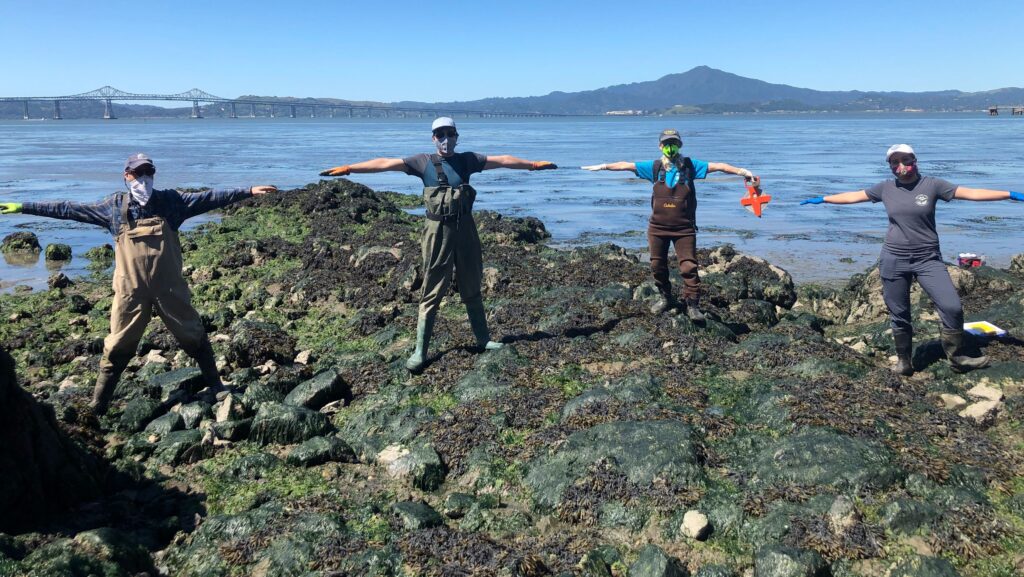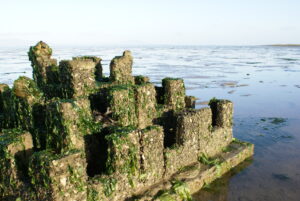by Aliya Uteuova

Left to right: Jeff Blumenthal, Acy Wood, Chela Zabin and Corryn Knapp do field work in Point Orient, a study site southwest from the team’s main living shorelines restoration site, Giant Marsh. (Credit: Ted Grosholz)
This is the first in a series of posts highlighting research the Smithsonian Environmental Research Center is continuing to do amid the COVID-19 pandemic, and adaptations its staff have been making in a more socially distant world.
Along the outer coast of San Francisco Bay, rocky, wave-crashing coastline gives way to acres of reefs. As the tides retreat, castle-like formations made of sand, oyster shells and cement reveal a living shoreline.
Since 2012, the San Francisco Bay Living Shorelines Project has used a nature-based approach to reinforce the shoreline and minimize coastal erosion while restoring critical eelgrass, Olympia oysters, and tidal marsh plant habitats. As a California State Coastal Conservancy public works project, it also falls under “critical infrastructure.” This meant scientists could still do socially distant fieldwork amidst the global pandemic.
“The shoreline protection might not seem too critical in 2020, but will be critical in 2050,” said Jeff Blumenthal, a technician with the Smithsonian Environmental Research Center’s San Francisco branch, or “SERC-West.”

Scientists think this rockweed algae, could provide shade to oysters and help them survive in a hotter climate. (Credit: Corryn Knapp)
Blumenthal works with SERC-West marine biologist Chela Zabin at another restoration site, the Giant Marsh project on the East Bay shore. Zabin’s team is focusing on Olympia oyster restoration. Olympia oysters live in the intertidal and subtidal zones along the Pacific coast, ranging from Baja California in Mexico to British Columbia in Canada. The scientists are particularly interested in whether rockweed algae could help alleviate the heat stress native oysters face as the planet warms.
“To our knowledge, this is the first effort to add macroalgae into living shorelines restoration,” Zabin said.
Like Olympia oysters, rockweed (Fucus distichus to scientists) grows in the intertidal zone. Rockweed grows in forms that adapt to environmental conditions. For example, it can grow into wider formations to withstand incoming waves and denser formations to withstand the drag of outgoing waves. This canopy-forming seaweed also provides shade to oysters, and could help keep them from drying out when exposed to heat. With climate change increasing the number of hot days, rockweed could give oysters a better shot at survival.

“Baycrete” reefs made of sand, oyster shell and cement are offering new habitat for oysters at the Giant Marsh restoration. (Credit: Alison Haigh/SERC)
Last summer, the team transplanted rockweed from a donor site onto the special “baycrete” reefs along the Giant Marsh. “Baycrete” refers to human-built reefs made up of 80 percent repurposed natural material from the San Francisco Bay. When created, the structures of sand, oyster shells and cement can look like marine castles, reef balls, or other shapes.
However, one challenge of restoration is the lurking chance of extreme temperatures jeopardizing months of work.
Last June, a couple weeks before the transplant, a heat wave hit during a period of extreme low tides. The blast triggered a severe die-off of plants and animals living in the intertidal zone, including rockweed.
“A lot of the Fucus died after we transplanted it last summer,” Zabin said. The team also had to scrap plans for this spring’s retransplant due to COVID-19. But they adapted to new working conditions swiftly, and are set to do another transplant this fall.
So far data indicate that in the project’s early stages, many oysters settled on reefs at lower tidal elevations. This left them less exposed they are during low tides. More oysters are also settling on the north rather than the south side of the blocks, characteristic of the oysters’ preference for cooler air temperatures during low tides.
For Zabin, the most exciting part of her work is reimagining restoration in the face of climate change.
“Traditionally, restoration has been a snapshot of what something used to look like, let’s say in 1800s, and we’d try to bring conditions to what it was,” Zabin says. “But as we face this unprecedented change, no conditions are ever going to be heading back toward what it was, and how we approach restoration projects now will make them resilient to extreme temperatures.”
This article has been corrected. The original version said Olympia oysters live in the upper intertidal zone along the Pacific Coast. The revised version amended this to state that they live in the intertidal and subtidal zones along the Pacific Coast.
More Research During COVID:
Plastic Cleanup Expedition Helps Research Stay Afloat During Pandemic
Carbon Sensors in the Time of Coronavirus
Orchid Hybrids Offer Clues for Conservation
TEMPEST Experiment Mimics Future Storms Inside Forests
How the “Blue Methane” Team Used COVID Restrictions To Get More Data Than Ever

